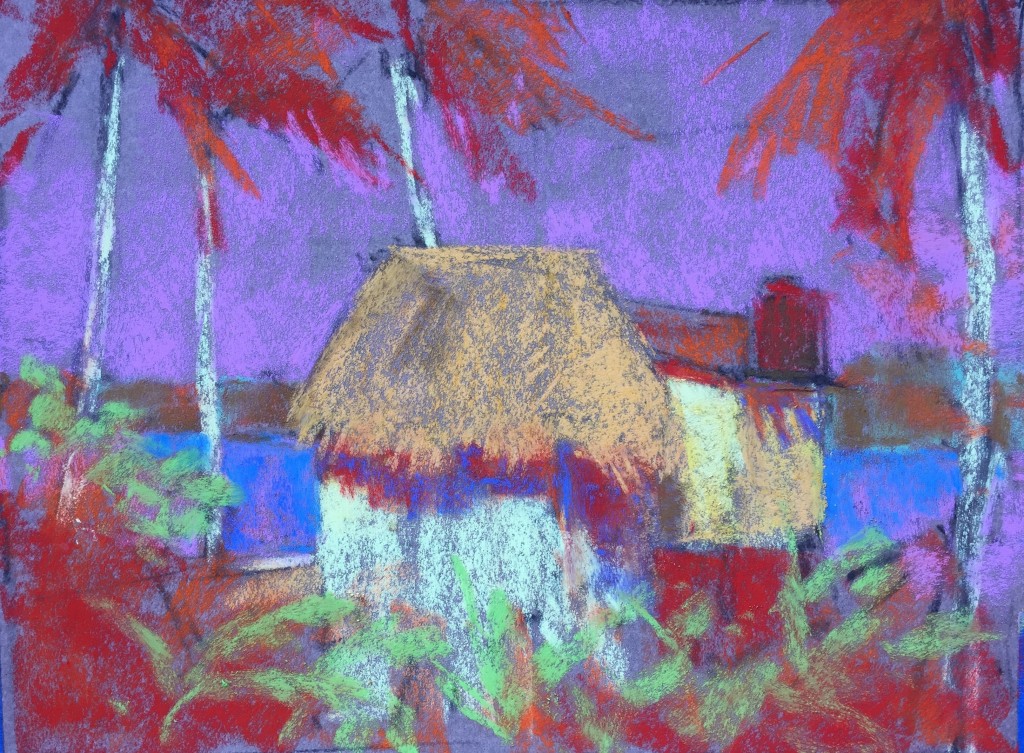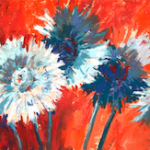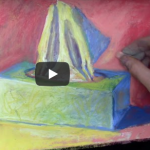We’re back from our two-week vacation in La Manzanilla, Mexico where we danced up a storm during the first week in a tango intensive workshop and then relaxed a bit in the second which is when I managed to get some pastelling time in. This pastel is a view from the verandah of Martin’s Restaurant. At first I was a bit overwhelmed by the scene until I spoke the mantra, simplify, simplify, simplify! It’s always good when you remember that you don’t have to put everything in – only include what you want to say something about. Let’s have a look at the view and the thumbnail sketch I did of it.










After an hour and a half of delightful pastelling in the shade of the restaurant palapa, it was time to go swimming!
After returning home to Victoria, I had a look at the piece and made some observations (follow along on the annotated image below). What I wanted to avoid was making too many ‘corrections’ thereby sapping the plein air life out of the piece!
1. The tree trunk about the building ended abruptly like some telephone pole – there was too much value contrast with the green above. Needed to have a softer transition.
2. Strange line in the sky needed to be softened.
3. I guess I had started to indicate clouds but this area just looks like a light puffball.
4. An unfortunate intersection between leaves and building post needed to be dealt with.
5. A lot of detail and contrast tends to keep the eye on the right side of the picture. I want..
6. ..the eye to circle around to the left so I need to..
7. ..lighten the far left banana leaf and…
8. …provide some interest in among the leaves and trunks to provide visual interest

And here’s the final pastel with all the changes made:

I hope this progression was helpful. It certainly shows how I simplify a scene to focus on what’s important to me. In this case, it was the interesting shadows cast by the thatch roof on the warm sunlit building and the strong verticals of the coconut trees. By leaving out all the other buildings, I could simplify what the viewer sees and hopefully by doing so, convey the feelings I had looking at this scene.
How do you simplify a scene when painting en plein air? Do you remember to use a viewfinder and to squint to help you simplify? What else do you do to simplify the overwhelm of painting on location? I’d love to hear from you!
Until next time,
~ Gail
PS. Want more info about pastelling on location? Why not take my online course, “Pastel Painting En Plein Air”? Click here for more info!
































18 thoughts on “Simplify, Simplify, Simplify! Working En Plein Air in Mexico”
Thanks Gail for showing your way of simplifying this painting, very instructive.
I have often thought of asking why you would choose the cobalt blue you so often use in your shadows else where. But here it really fits in with the strong Mexican sun light.
Glad it was helpful Susana 🙂
As to the blue in shadows, it’s usually what I see (reflecting the sky?) and also, it’s to do with the limitations of a limited palette!
Hi Gail,
Nice one! I can feel the tropical breeze blowing thru this piece and warmth of the sun. It was a surprise to see how many points I missed looking at the original plein air and the annotated. It’s the critical thinking and finalizing that is so difficult. I can see the value in setting the piece aside after working intently and taking a second look after a rest for eyes and mind. For your question how do you simplify:
All of the above of course but by focusing on the quality of the light and its effects on my chosen center of interest it helps to keep me from taking in all the little details and diverting my attention. Again, thanks for sharing your annotated version – your experience is so helpful.
Gailen
Gailen thanks for sharing the way you simplify!
Yes, it is valuable to allow some time between when you finish a piece and reviewing it. All sorts of things can pop up that you didn’t notice in the flush of the painting moment. Being critical of your own work I think is one of the most difficult parts of painting. It’s funny how it’s much easier to be critical (and I’m talking in a good way) of work by others. I think it’s to do with our detachment from the piece – we don’t have the time, effort, energy, and passion invested as the artist does.
I’m glad this was helpful. I’m also happy you could feel that warm tropical breeze 🙂
Gail, thank you! I really look forward to How to Pastel but especially when it’s you talking about your work!
This is so helpful! I simplify mostly by squinting or using a piece of red film, or just thinking about what I’m viewing in terms of shapes, not detail.
Hi Becky, I’m so glad you enjoy me talking about my work! I sometimes feel it’s all the other stuff that’s more beneficial so I am delighted to get your feedback!
And thanks too for your ideas on simplifying – all excellent. I think we all need reminding to exclude the detail and focus on the big shapes!!
Hi Gail,
Thanks for sharing” The Making Of ” with us! I was especially impressed by how you made the sky look so interesting, not just BLUE.
I was wondering what you do about pastel dust on your hands when you are painting outdoors. I always try to keep my hands clean to not smear colors where they shouldn’t end up but also because it’s often toxic and I never know where it gets in my face or even my mouth. When I started with charcoals I ended up looking like a chimney sweep so I’m sure I’m just as messy with chalk pastels! Sennelier uses lots of toxic pigments which makes me feel uneasy.
Hey Pamela, I’m glad you enjoyed ‘The Making of” (I like that!).
Well, my hands do get dusty that’s for sure. If I’m on location in my own neighbourhood, I always have some wet towelettes available. Sometimes I use gloves but my hands get hot and sweaty and also, that doesn’t prevent the dust getting on my face or wherever I touch! Mind you, I try to consciously not touch anywhere else. The other thing I have whether working close to home or travelling, is a small roll of toilet pape: I use it to clean my pastels but also my hands. The main thing is, I try not to eat or drink anything until I’ve washed my hands. It’s not easy being clean!!
As to toxicity, the main thing to worry about with pastels is breathing the dust or ingesting it. The particles won’t easily pass through the skin barrier as there is no solvent like turpentine (deadly!) to take it through. I think most manufacturers are using less toxic pigments but sometimes, it cannot be helped if a certain colour is required. These pastels are well marked with health warnings. Still, it’s always wise to take precautions!
Hi, Gail! Just a quick question. I am planning a trip to Alaska this summer and I want to bring my pastels What is the minimal packing list? Thanks! Betty Smith
Hi Betty, I think perhaps I’ll write a blog post about this topic! In the meantime, here’s what I took to Mexico (and this is minimal!!): small box of pastels, board, pre-cut paper and glassine to cover, tape, small styrofoam tray, an apron, a large trash bag (good to sit on!), small roll of toilet paper (for cleaning pastels), a cap, small sketchbook and pen for thumbnails. I forgot my viewfinder but that’s always handy. I think that’s it!
Very interesting demo and critic of your own work. Hope you are getting a lot of interest in your demos and informative description of yours and other paintings. Those that are not tuning in to your blog are missing so much!!!!
Thanks! EI notice that every time I send out a blog, my audience has grown by 20-40 people so yes, I think more and more pastellists are tuning in. Yay!! 🙂
Hi Gail! Thanks for this demo. I think for me, creating a thumbnail first after using a viewfinder helps me simplify. Big simple shapes of value on the paper using a hard pastel in complimentary colors and an alcohol wash. Limited palette .
Love the tropical feel of this painting, I can almost hear the Mariachi band playing🎶🎶🎶
Thanks Sandi for your input on simplifying – a big yes to all!
Glad you can hear that Mariachi band in the background. (In actual fact, I believe the Gypsy Kings were helping me along.)
great instruction…I especially like what you did and shared after you went in with fresh eyes afterwords! Very helpful. It is still a plein air painting imho. Why some of the purists frown on that is a mystery to me.
Thanks Gail!
Your welcome Cathyann and thanks! I’m glad it was helpful.
I consider it a plein air pastel too!
Hi Gail,
Thank you for sharing. Love all the colors you used in this painting, you can feel the warmth of the sun. Beautiful!
Hi Alicia! Many thanks for adding a comment. So glad you can feel the warmth that was sooooo in this scene. I sat in that chair this recent holiday and looked out on a completely different scene. You can’t see the wee structure for all the banana trees and other foliage. You can’t even see the sea looking in that direction!